
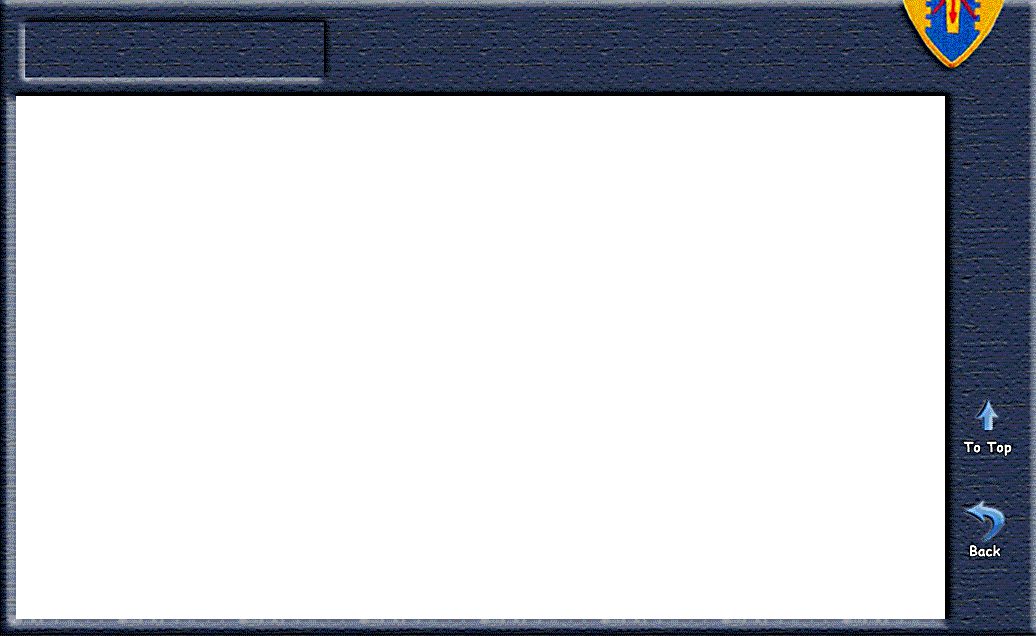
see other Nighthawk Stories: Minigun 69, Sniper, 1971, Aug 71, Allen Video, Bored Crew, Avn Digest Article, Marcinkowski Video,

US Army Aviation Digest Magazine - November 1969
Firefly, Flashlight, Night Hunter and now Nighthawk have been making the nights unhealthy for Charlie
CPT Garrett C Marcinkowski & CW2 Steven G. Zorger
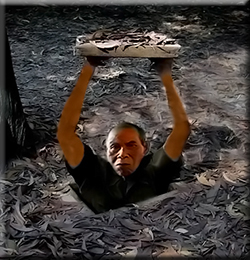 Carefully, the camouflaged cover for the tunnel is moved aside. Into the dank wetness of the hole comes the aromatic scent of the lush Vietnamese night filling the grateful lungs of Nguyen Van Ti.
Carefully, the camouflaged cover for the tunnel is moved aside. Into the dank wetness of the hole comes the aromatic scent of the lush Vietnamese night filling the grateful lungs of Nguyen Van Ti.
Nguyen and his squad had been in the tunnel all day afraid to move because of the enemy helicopters and troops in the area. But now the protective mantle of night had fallen and the squad could again move undetected with its precious rockets for the impending attack on the Yankee base camp. He must not fail in his mission. The target is the headquarters, the nerve center of the American camp. In single file the men leave the tunnel, stepping carefully to avoid the many booby traps placed to protect their lair. “Good,” thinks Nguyen, “the moon is only one quarter. It is enough for us to see but still offers the protection of near darkness.” No sound is heard from the men as they toil their way through the dense underbrush with their bulky and heavy loads. For two hours they march and – “Hold!” That noise? It is an accursed helicopter. Don’t move!”
Nguyen searches the black sky, but can see nothing. “It is near, I know, but perhaps it is the strange thing that sound does on a quiet night. There is no sign of the machine.” Nguyen signals to his men “Quickly, we have but 30 minutes before we must be in position”.
The men rise, nervously searching for an unseen noise in a star-studded sky. Taking up the pace, they move along the trail in single file. “Perhaps it is only an emergency light from one point to another. The Americans fly at night only when the need arises.
“Aahh! That light! What is it? I am blinded. What can I do?” A fierce glare envelopes the men, frightening them into a frozen stance much like deer. They do not stand long because they are taken under fire with a weapon which shoots at amazing speed and with deadly accuracy.
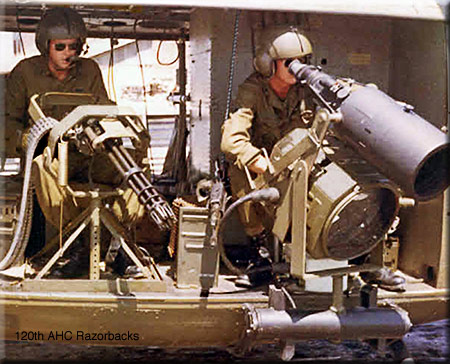 Nguyen sees his men crumple like puppets which have lost their strings. A round finds a rocket and with a terrifying roar half his men disintegrate before his eyes. Suddenly, he is hit in the back and as he begins his fall in a world quickly turning hazy and red he wonders, “What is this? How did they know we were here? What terrible weapons do they have?”
Nguyen sees his men crumple like puppets which have lost their strings. A round finds a rocket and with a terrifying roar half his men disintegrate before his eyes. Suddenly, he is hit in the back and as he begins his fall in a world quickly turning hazy and red he wonders, “What is this? How did they know we were here? What terrible weapons do they have?”
Nguyen will never know, nor will his men. They lie on the trail somewhere in the jungle northwest of Saigon. Their rockets will never be fired.
In the air, the helicopter pilot speaks into his radio, “Sighted 10 men with rockets and weapons on trail near XT473485. Engaged with minigun and automatic weapons. Results, 10 body count, one secondary explosion. Continuing mission, over.”
Fiction you say! No, it is the truth and is happening with astonishing frequency in the 25th Infantry Division’s area of operation. Flying all night in a specially outfitted helicopter, the “Centaurs” of Troop D (Air), 3rd Squadron, 4th Cavalry, have compiled an outstanding record of enemy body count and enemy equipment destroyed, all without loss to themselves.
Currently, in the 25th Inf Div six Nighthawk aircraft prowl the skies in specific areas. In this manner a large area can be covered during the hours of darkness. Both the 25th Avn Bn and Trp D (Air), 3rd Sqdn, 4th Cav, take primary responsibility for this mission.
The “Nighthawk” is becoming a fixture during the hours of darkness in the division area. It is a UH-1H lift helicopter fitted with special equipment to give it a unique capability of se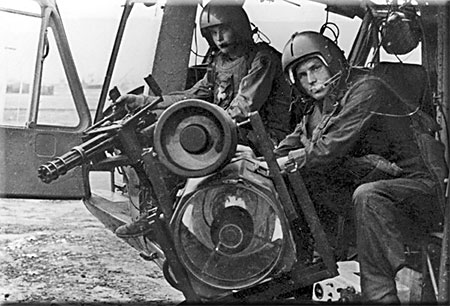 eing without being seen.
eing without being seen.
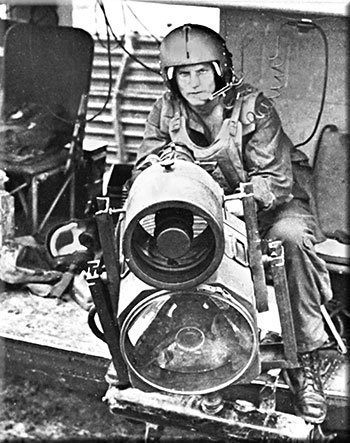 In the left rear door gunner’s well, a xenon searchlight and a night observation device are mounted coaxially with the xenon light acting as the light source for the device. The searchlight has two modes of operation, infrared (IR) and “white” light. When the searchlight is operated in the IR mode, the operator can observe objects on the ground using a night observation device without giving his position away. In addition, the infrared beam increases the range of the infrared device, allowing the aircraft to stay above 1,000 feet.
In the left rear door gunner’s well, a xenon searchlight and a night observation device are mounted coaxially with the xenon light acting as the light source for the device. The searchlight has two modes of operation, infrared (IR) and “white” light. When the searchlight is operated in the IR mode, the operator can observe objects on the ground using a night observation device without giving his position away. In addition, the infrared beam increases the range of the infrared device, allowing the aircraft to stay above 1,000 feet.
When a target is acquired, the light operator notifies the doorgunner positioned behind the left pilot’s seat. The gunner is equipped with a minigun mounted on a locally manufactured mount. The minigun uses an LOH brainbox and fires at a rate of 1,500 rounds per minute. This rate of fire is more than sufficient and the operator does not have the increased problem of control when firing at a rate of 4,000 rounds per minute.
Close coordination between the light operator and doorgunner is essential. It must be remembered that when the light is operated using the IR mode, the doorgunner cannot see any target. The light operator must give a clock azimuth and approximate distance of the target to the man on the minigun, i.e., four North Vietnamese at 10 O’Clock and 400 meters (12 O’Clock is the nose of the aircraft.)
The aircraft commander then will brief other elements of his team if applicable. (These elements will be discussed in greater detail in later paragraphs.) The light man will give a three second countdown to the other members of the crew and switch the light from the IR mode to white and the target is immediately engaged with devastating accuracy.
On the right side of the aircraft two gunners armed with M-60 machineguns give protection to the aircraft if fired upon. They have no means of detecting targets other than visual. Between the light operator and minigun operator, another gunner with a free M-60 offers additional firepower to insure complete coverage of the acquired target. Usually 8,000 to 10,000 rounds of 7.62 ammunition are carried on each mission. By the end of the night most of it is gone.
One can readily see that crew coordination is of prime importance. To this end, one crew is permanently assigned to fly the Nighthawk aircraft. Although these men cannot participate in missions the next day, the aircraft can be reconverted to a liftship in less than 30 minutes. The recon capability of the air cav troop is thus increased with no appreciable reduction in mission readiness.
The Nighthawk’s mission is simple: find and destroy the enemy. Because of its simplicity, its employment can be varied considerably to fit the area or type target expected.
Normally the aircraft is employed a single ship; this allows it to roam freely. The firepower of its door-mounted guns gives it the capability of engaging almost any target against which a gunship can be employed. The aircraft is flown at an altitude between 1,000 and 1,300 feet and is completely blacked out. However, being blacked out does not make it a wraith in the sky to other aircraft. The ship is on radar and has sufficient warning from ground controllers of nearby or approaching aircraft so that is can take evasive action Therefore, Charlie can hear the aircraft but cannot see it. The element of surprise is increased and the possibility of ground fire greatly reduced. In 45 days of operation, Centaur Nighthawk ships have taken only one hit.
Should the area be considered “hot,” a gunship may accompany the Nighthawk to offer added protection or to engage large targets with rockets. In this case the gunship flies blacked out and the slick uses only his anti-collision light. It has been found that gunship coverage does not increase the kill ratio to any appreciable extent. Gun teams of the 3/4 Cav are kept on a five minute standby and can be scrambled to any location on short notice. Artillery and air strikes are also included in the pilot’s bag of tricks.
The Nighthawk can be given the mission of roaming an assigned area with the express purpose of engaging enemy forces whenever they may be found. The aircraft also can be taken to support specific ground units in night laager position or fire support bases. In either case, prior coordination with the ground troops is necessary.
In the first instance the area will generally be a known enemy stronghold where no friendly forces are situated. The mission commander must learn his assigned area of operations and where the closest friendly forces (if any) are located. Naturally all necessary frequencies will be known before departure. It is desirable that he also obtain permission to engage targets of opportunity prior to taking off on the mission. This makes his job easier and will insure greater body count.
When supporting a specific ground unit, a more detailed briefing on locations of ambush patrols, listening posts, etc., is mandatory. In fact, an observer from the supported ground unit may be included in the crew to identify locations or give permission to fire.
Support has been given to numerous fire support bases and night laager positions in this manner and has proven to be extremely effective. In one night’s operation in support of a fire support base near Cambodia, the Nighthawk ship killed 22 enemy troops who had been in the trees or approaching the friendly position’s perimeter.
In every case one must consider the psychological effect of such an aircraft. The night used to belong to Charlie. In the past he has moved and attacked with near impunity between sunset and sunrise. With the Nighthawks, he must think twice about moving in large groups any distance at all. Each time a helicopter is heard his movement must cease. He cannot take the chance of it being just another aircraft. He must assume is has the capability to see him.
Consider also the friendly psychological effect on a supported unit. A ground trooper is likely to breathe a little easier with such an aircraft overhead.
Because of the aircraft and mission flexibility, various aircraft can be added to the mission to give it a special flair. The variations are limited only by the ingenuity of the user.
A great deal of the night still belongs to the enemy. But the ingenuity of the commanders and dedicated pilots on such operations as Firefly, Flashlight, Night Hunter and now Nighthawk have made serious inroads on the Viet Cong and North Vietnamese claims that “the dark is our cover.” The future bodes ill for Sir Charles.